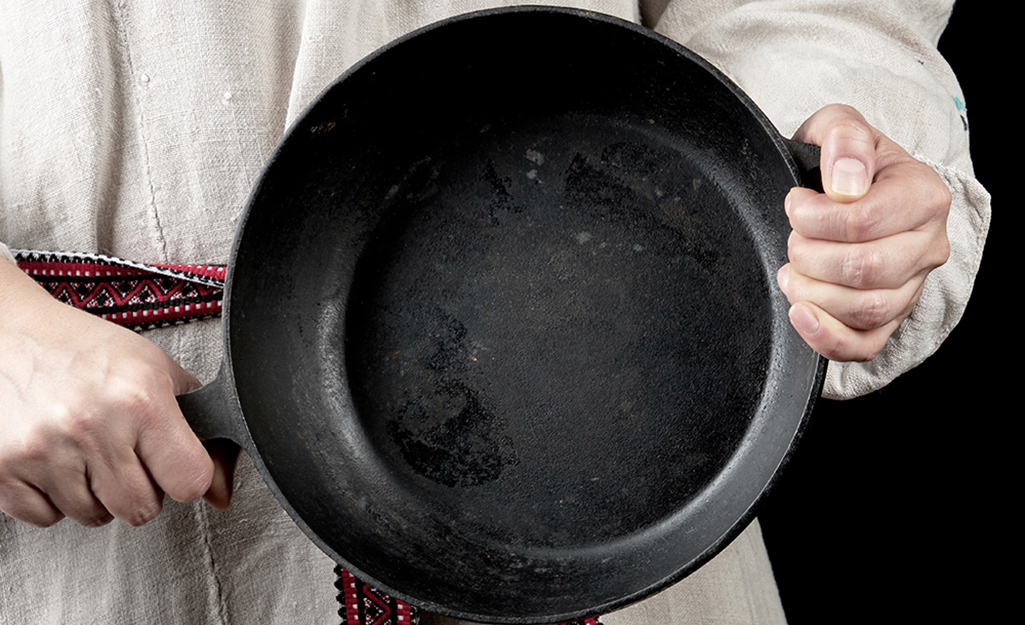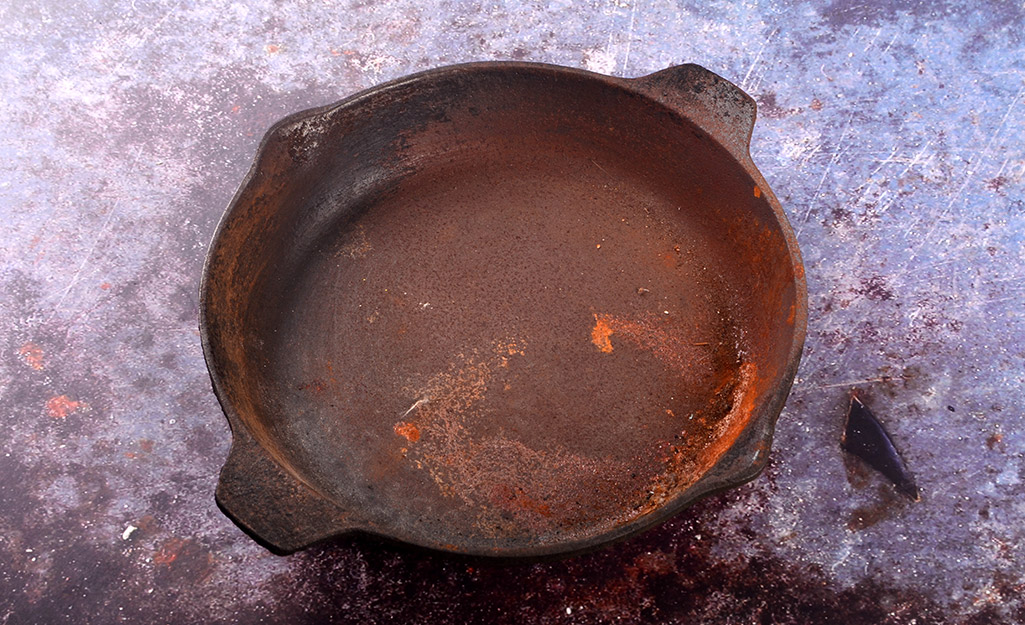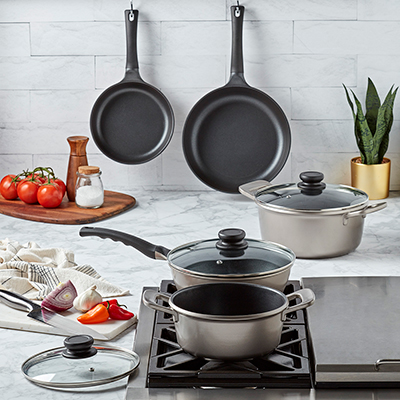How to Clean a Cast Iron Skillet

Last updated September 7, 2023
Many people call their cast iron skillet one of the most prized possessions in the kitchen. It is of the most durable (and possibly the heaviest) pieces of cookware. Cast iron skillets retain heat and turn out crispy potatoes and perfectly seared pork chops.
A cast iron skillet might require some special care, but the extra attention is worth it. You may have just purchased one, or have been cooking with your cast iron skillet for as long as you can remember. Read this guide for best practices and cleaning methods so you can learn how to clean a cast iron skillet.
Difficulty:
Beginner
Duration:
Under 2 hours
Table of Contents
How to Wash and Dry a Cast Iron Skillet
How to Care for Cast Iron
How to Cook with Cast Iron
How to Season a Cast Iron Skillet
How to Restore a Cast-Iron Skillet
How to Wash and Dry a Cast Iron Skillet

No matter how well-seasoned your cast iron cookware is, it’s inevitably going to get dirty. When it comes to cleaning cast iron, it’s important to note what you shouldn’t do.
Pay attention to how to wash a cast-iron skillet. Don’t throw it in the dishwasher or use metal scouring pads and harsh abrasives for everyday washes, because they can remove the seasoning.
Once you’re through cooking with your cast iron skillet, wash it by hand using a nylon bristle scrub brush while it’s still warm (this actually makes cleaning much easier). You can opt to use rubber gloves, if needed.
If there are still bits of stuck food, use a plastic pan scraper or a chain mail cleaning tool for cast iron cookware. You can also simmer a little water in the pan for about one minute before scrubbing to loosen debris.
Afterward, you’ll want to dry it as soon as possible with a lint-free cloth or paper towel. Then, gently reheat the pan on low heat and rub a very light layer of cooking oil into the cast iron skillet using a dry paper towel. This process is seasoning the skillet; the heated oil bonds with the cast iron to create a nonstick cooking surface that also helps prevent the skillet from rusting.
And in case you were wondering, washing your cast iron with a little bit of gentle dish soap is just fine, according to experts. Keep in mind, it's best to avoid tough scouring pads.
A favorite way to clean cast iron requires something you use all the time in the kitchen: salt. The method is easy.
- Take a big pinch of coarse salt (kosher salt, but sea salt also works) and sprinkle it on the cooking surface.
- Then, take a clean paper towel and scrub the salt around the pan until any stuck-on food bits lift right off.
- Dump the salt into the garbage and, if you want, rinse off the cast iron skillet with water and dry it thoroughly.
Another clever kitchen method for cleaning cast iron is to use a half a potato along with the salt. Sprinkle the coarse salt into the pan and instead of using a paper towel, cut a white potato in half and use the cut side to scrub the salt around the pan surface. In addition to the moisture in the potato, there is a natural oxalic acid that dissolves any rust or burned bits.
How to Care for Cast Iron

Cast iron cookware is tough, but despite its reputation, it isn’t indestructible. Taking a little care with your cast iron skillet is necessary to ensure its long life.
- Handle cast iron pans carefully and don’t let them take any knocks, especially against an exceptionally hard surface like a stone countertop or concrete floor. The pan can chip or even break.
- Avoid superheating the pan and never add cold water to a hot pan. This can ruin or damage the pan.
- Be sure to clean your cast iron skillet after every use. A light cleaning will help keep the skillet over time.
Sometimes your cast iron pan may be sticky after seasoning. This may be caused by cooking food with sugar or food with a lower fat content. You may need to scrub the pan with a sponge and re-season to solve this.
How to Cook with Cast Iron

The easiest thing you can do to take extra good care of your cast iron skillet is to use it! Cooking with your cast iron skillet regularly with any kind of cooking oil is an excellent way to keep your cookware in tip-top shape.
Along that same train of thought, until you build up a good layer of seasoning in your cookware, food is probably going to stick to it. If you use it every day, it’ll be thoroughly seasoned in just a few weeks. If you use it every now and then, it could take up to a few months. You should always thoroughly dry and oil it after every use (just as in the cleaning method described) to avoid problems like rust and scaling.
One thing to know when it comes to cooking with cast iron: You should avoid using it to cook highly acidic foods. The acidity of foods like tomatoes and tomato sauce, wine-braised meats, citrus juices and even beans can strip down the seasoning and make your food taste metallic.
Avoid cooking these types of foods at least until you’ve got a super-thick layer of seasoning. in your cast iron skillet. Cooking fish and omlets in a cast iron skillet is also discouraged, as these foods could stick to the surface and make turning difficult.
You can, however, cook with any utensils you like, even metal ones. Cast iron is tough, so it can handle pretty much any type of utensil once it’s seasoned.
How to Season a Cast Iron Skillet

The most important thing you can do for cast iron cookware is give it a proper initial seasoning, even if it comes “pre-seasoned.” You should also season it at least once a year and more often if you use it regularly.
Choosing the right kind of oil for seasoning is essential for getting a slick surface on your cast iron. It is important to use an oil that has a high smoke point and does not easily go rancid, which eliminates a lot of standard cooking oils as best bets.
Organic flaxseed oil and organic avocado oil are both good choices for types of oil to use for seasoning cast iron. Flaxseed oil is considered a drying oil which means that it will season to a hard film on the surface of the pan. Avocado oil has a very high smoke point and is less expensive than flaxseed oil, even in an organic variety.
How to Restore a Cast-Iron Skillet

How to clean a rusty cast iron skillet is a little more complicated. When it is a question of removing rust or burnt-on food, the usual rules of cleaning a cast iron skillet can bend a little.
Normally, you would avoid introducing cast iron to harsh acids. However, cast iron skillets in need of restoring can stand up to a little more rigorous treatment. The main thing to remember is to dry the pan thoroughly and season it well after you have recovered it.
For spots with rust, you can once again turn to cleaning your cast iron with salt. This time, add a little lemon juice.
- Cut a fresh lemon in two pieces and dip the cut end in kosher salt.
- Rub vigorously over the rusted spot, adding salt as needed, until the rust is lifted from the surface.
- Wash the entire surface of the pan with a little mild dish soap and warm water, rinse thoroughly and dry the pan well.
Scouring the surface with steel wool is also an excellent way to lift both rust spots and burned-on food particles from a heavily damaged pan.
- Use a fine grade steel wool pad and scrub the pan surface, inside and out, to remove rust and debris.
- Wash the residue with hot water and mild soap if needed.
- Once you have cleaned all the residue off the cast iron skillet, wash and dry your skillet as noted.
Once you’ve restored your cast iron skillet, you must at once re-season the pan. If you wait, you may allow rust to re-establish itself. Be sure to repeat the process at least three times to ensure your pan has a solid protective layer.
Cast iron is not a dishwasher-safe skillet, but the beauty of these pans make them more than worth the little bit of effort required in cast iron skillet care. Proper cleaning and care extends the durability of your cast iron skillet. Download The Home Depot Mobile App to get the supplies you need to keep your cast iron cookware in excellent condition.



























